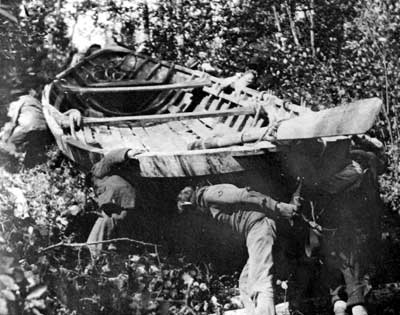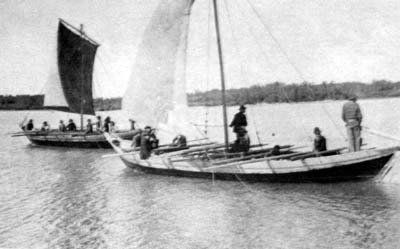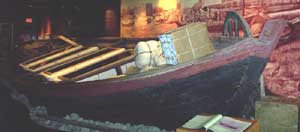Just about everywhere where water laps a shore, people have
developed boats. The nature of water makes certain demands
on the form of a hull, but boats have been invented and reinvented
in astonishing variety. In each place they were built to suit
the local conditions and available supplies and in accordance
with the local idea of a boat.
The early history of the area around here is dominated by
the push and pull between the Indians and the fur trade. In
1670 King Charles II granted the Hudson Bay Company sovereignty
over all the lands that drained into Hudson’s Bay, when
he hadn’t a clue about the vast area that was involved.

York Boat
For the 200 years before they opened up department stores,
the HBC carried on a marginal business providing beaver pelts,
which were the raw material for felt top hats. They established
forts on the shores of the Bay and recruited men and boys
from the Orkney Islands to man them. The Orkneys had the reputation
of being the coldest and most miserable part of Britain, but
when the Orkneymen arrived they were still shocked at the
brutal cold of the Arctic winters.
The Indians had been here from the dawn of time. The land
for a thousand miles east of here, and a thousand miles north,
is composed of equal parts rock, water, and swamp. Until the
float plane was invented the canoe was the only way to get
around when the lakes weren’t frozen over. The birch
bark canoe could be made to weather the largest lakes and
still be light enough to be carried around rapids and between
river systems. It was built with a green split wood and sapling
frame, covered with the bark peeled from birch trees, sewn
together with roots and sinews, and caulked with spruce gum.
It could be anywhere from twelve to thirty feet long. It was
propelled by single bladed paddles.

A birchbark canoe (click to enlarge)
Around 1800 the HBC discovered that the people that were
providing them with pelts and furs were becoming less willing
to paddle up to Hudson’s Bay. The Northwest Company,
upstarts from Montreal, were sending brigades of canoes, through
the Great Lakes, and up the rivers to short cut the supply
chain. This meant paddling through the Great Lakes and a 3,000
mile round trip from Fort William at the head of the Great
Lakes to Athabaska, all in the seven months that were ice
free. The Northwesters managed to find men desperate enough
for the job and they could still turn a profit.
The HBC responded by building a fleet of York boats. The
York boat was a double ender, twenty-eight to forty-five feet
long, carvel planked on steamed frames, built from timbers
brought in as ship’s ballast. It was raked 45° stem
and stern, plenty of flare at the shear, with round bilges,
and a heavy straight keel. It was a direct descendant of the
boats that were launched through the surf in the Orkneys,
which in turn descended from the Viking longboat. They were
so heavy that railways were built to manhandle them around
the larger rapids. They were rowed by a crew of eight or ten,
carried a square sail in open water, and when the upstream
current was severe, they were lined from shore.

York Boats
There are people that still make birch bark canoes, but
only a few and only to keep up the tradition. The tradition
of York boats is kept alive in the isolated community of Norway
House at the north end of Lake Winnipeg. They build them for
the annual races at York Boat Days.

York Boat (click to enlarge)
There are plenty of canoes made all over the world; aluminum,
fiberglass, Kevlar, and wood/epoxy. The preferred size here
is sixteen to eighteen foot, which can stay dry in the chop
of all but the largest of lakes and can still be carried by
the two paddlers over a three mile portage, together with
packs in one trip. The ability to portage, that is French
for carry, without backtracking is a sign of an accomplished
canoeist. The old paddlers regard the cedar strip and canvas
canoes made up into the 1960’s by Peterborough and Chestnut
as the height of the art.

Portaging a York Boat
The are no descendants of the York boat, except perhaps in
spirit, the yawlboat, a fiberglass open commercial fishing
boat used to set gill nets on the big lakes here. From eighteen
to thirty feet long, they charge over the swells that build
up in a hundred mile fetch of shallow water.
The Manitoba Museum has a fine York boat, a birch bark canoe,
and a couple of skin kayaks on display. The Canadian History
Channel produced a series called Quest for the Bay
which documented a trip made from Red River to Hudson Bay
in a York boat using 19th century equipment and supplies.

